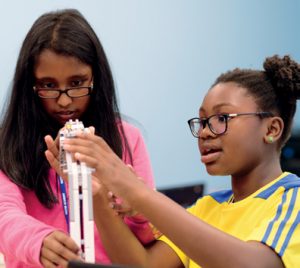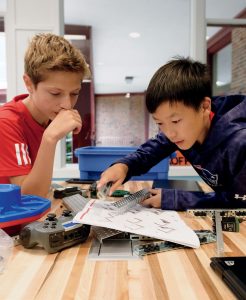
A Place for Discovery and Design Middle and Lower School students come together in a design thinking space

What happens when a fish is not a fish?
In Bridget Sitkoff’s seventh-grade computer programming class, it means that a student’s math didn’t work out quite right. She holds up a 3-D printed figure that a boy made in class: There was a funnel shape that should have been a conelike fin.
“I love this one. I love that it’s upside down,” Bridget says. “How can you understand where something went wrong? Well, you get this out of the printer and say, ‘Oh.’ It’s more physical and tangible and real than when you get a math test back and a problem is wrong. When your fish isn’t a fish, that’s something you can understand right away. It fits in perfectly with the algebra the seventh-graders are currently taking, so I can meet them where they are in math.
“It’s not me telling them they did something wrong,” she continues. “It’s them saying, ‘Wait, that’s not what I meant to make.’ There’s real power to that. But it’s also real computer science. They’re writing real code.”
Bridget is the technology integration specialist in Milton’s Middle and Lower Schools. She works with students through Grade 8, blending computer science, math, robotics, engineering, and virtual reality in age-appropriate forms that apply math and coding concepts to technological discovery.
 Most of this work happens in a sun-filled section of the Perry Reading Room in the Caroline Saltonstall Gymnasium, a design thinking space that was renovated last year and includes two 3-D printers, a table for VEX and Lego robotics, a smartboard, and tech gadgets such as virtual reality (VR) headsets. The architect who designed the space was Lyle Bradley ’95; he just “got it” in the development of a welcoming lab that is practical and fun, Bridget says. At any given moment, students may be there writing code to create images on their laptops, or studying new programming languages, or learning to program micro:bits (small, handheld microcontrollers) to operate cars they’ve built.
Most of this work happens in a sun-filled section of the Perry Reading Room in the Caroline Saltonstall Gymnasium, a design thinking space that was renovated last year and includes two 3-D printers, a table for VEX and Lego robotics, a smartboard, and tech gadgets such as virtual reality (VR) headsets. The architect who designed the space was Lyle Bradley ’95; he just “got it” in the development of a welcoming lab that is practical and fun, Bridget says. At any given moment, students may be there writing code to create images on their laptops, or studying new programming languages, or learning to program micro:bits (small, handheld microcontrollers) to operate cars they’ve built.
During a Middle School class in early October, Bridget encouraged students to play around with different sequences for code, with the objective of drawing a tree. The mood was energetic, filled with kids proudly showing off their successes, asking one another for help, and laughing when their plans went sideways. If something failed, Bridget told them, keep trying: “Nothing is going to break if you make a mistake.”
During breaks in the day, students drop in to play board games, work on robots or other projects, or explore VR or augmented reality programs. Before the room was created, programming activities were somewhat scattered, with students working on projects in hallways. Bridget had to store equipment and projects in the basement of Greenleaf Hall, and students would have to ask her to unlock it if they wanted to revisit a project outside of class. Now they can access it during any free or activity time, which means “it’s always kind of a mess in here, but it’s kid-made,” Bridget says. The new space feels like their own.
“It has been huge for us to get this dedicated space,” she continues. “Kids can store things they’re working on and find the equipment they need. Middle and Lower School kids feel equally comfortable and welcome here, and there are not a lot of spaces where that organically happens. At recess, everyone’s here, from third to eighth grade. They don’t always interact with each other, but you’ll see them checking out what other kids are making.”
 Over the past few years, more girls and students of color have become involved in programming and robotics in the Lower and Middle Schools, in part because of mentorship by Upper School girls. Their examples, and the new, open-to-all space, have made the younger students feel more comfortable joining these activities, Bridget says. Avery Miller ’20 helped lead the charge.
Over the past few years, more girls and students of color have become involved in programming and robotics in the Lower and Middle Schools, in part because of mentorship by Upper School girls. Their examples, and the new, open-to-all space, have made the younger students feel more comfortable joining these activities, Bridget says. Avery Miller ’20 helped lead the charge.
“Avery came to Milton in fourth grade, and through her Middle School years, she was one of the only girls in all these programs. She was really determined to make sure it wouldn’t stay like that,” Bridget says. “She’s been a huge ally in coming to talk to girls about why they might want to sign up and what her experience has been. She’s helped to build this program up.”
Working with computer programming faculty members in the Upper School, Bridget has designed a curriculum to prepare eighth-graders for — and excite them about — what they’ll encounter once they reach their high school math and programming classes. All ninth-grade students work with the programming language Java in their geometry classes, so Grade 8 students learn related concepts. “We want them to be ready with the skill set, but also be appropriately challenged once they reach ninth grade,” she explains.
Today’s students are digital natives, comfortable users of technology, because it’s always been a part of their lives. But that doesn’t automatically equate to skill development, Bridget says. She hopes adults will focus less on the time students look at screens and more on the quality of their screen time. It’s one thing to watch videos on YouTube, and another thing to make something brand-new, combining math, coding, and creativity.
“If you don’t teach them to be creators of technology, they won’t be,” she says. “We want our kids to be creators, not just consumers. It’s great that young kids can access information online, but can they get their own ideas across and share them using technology? Because that’s a totally different thing. I care about that more than their facility with looking something up.”
Marisa Donelan




